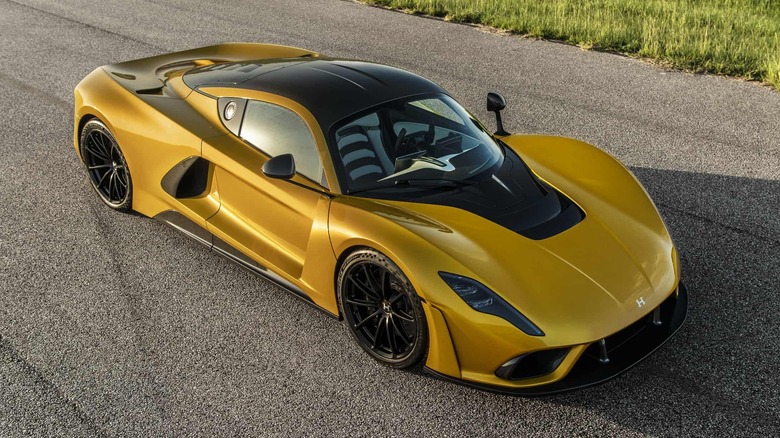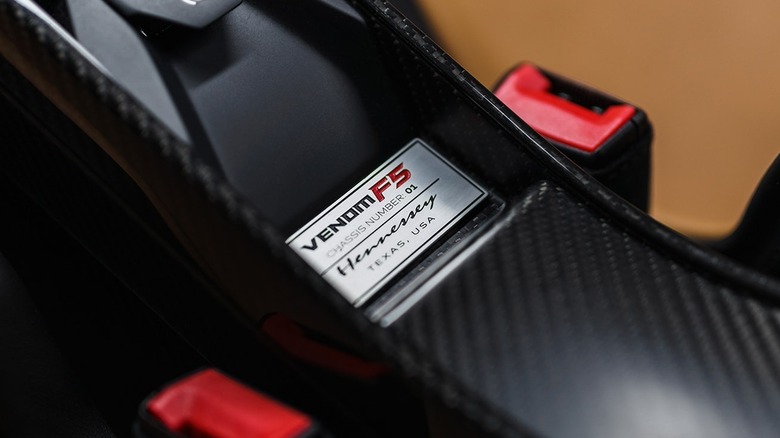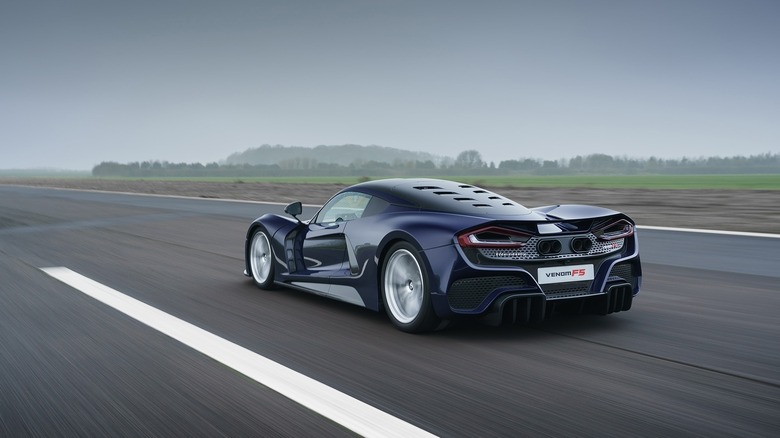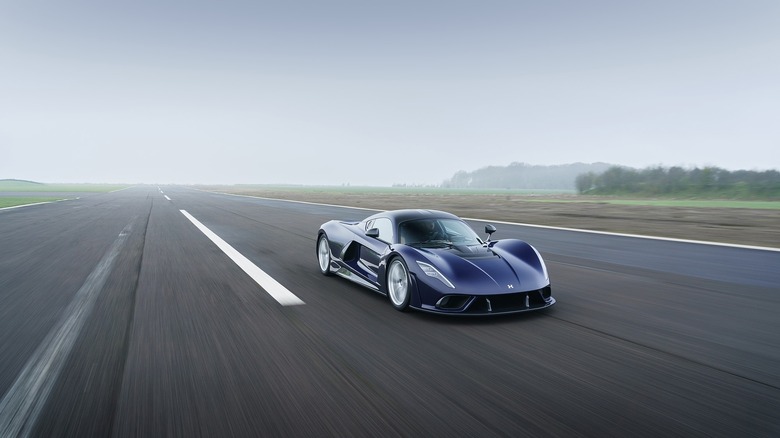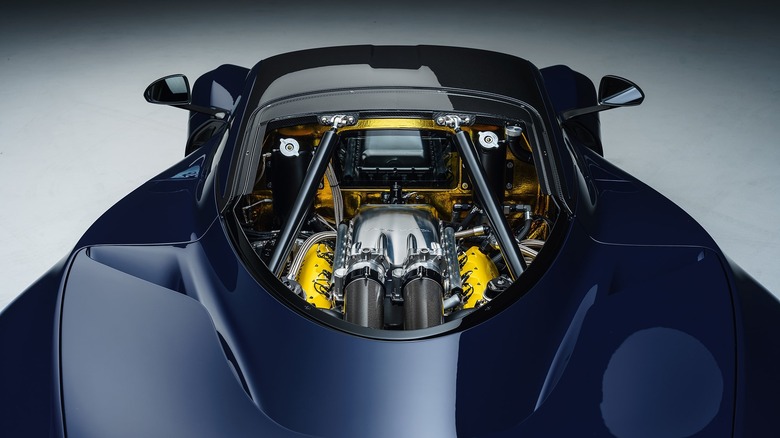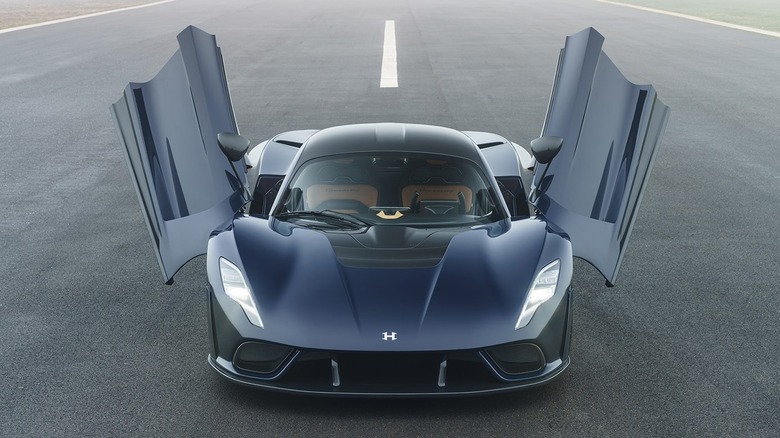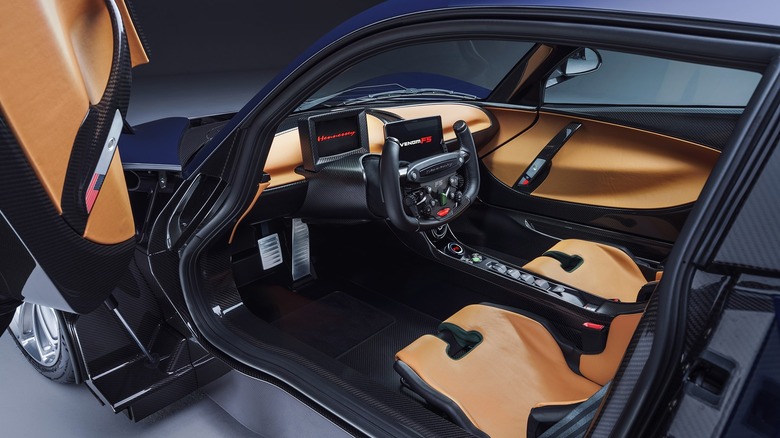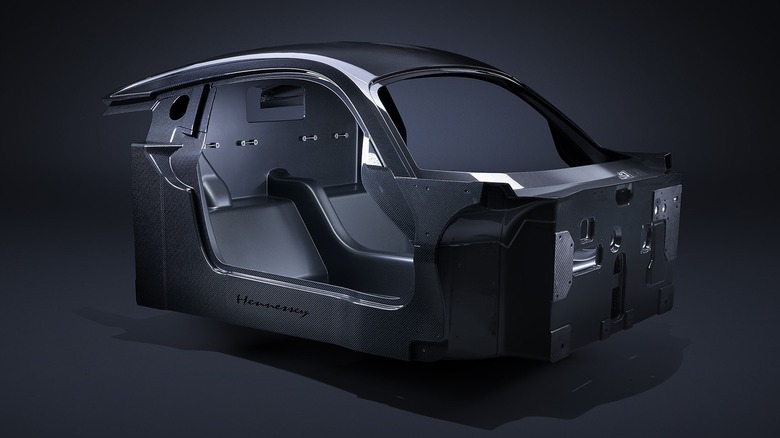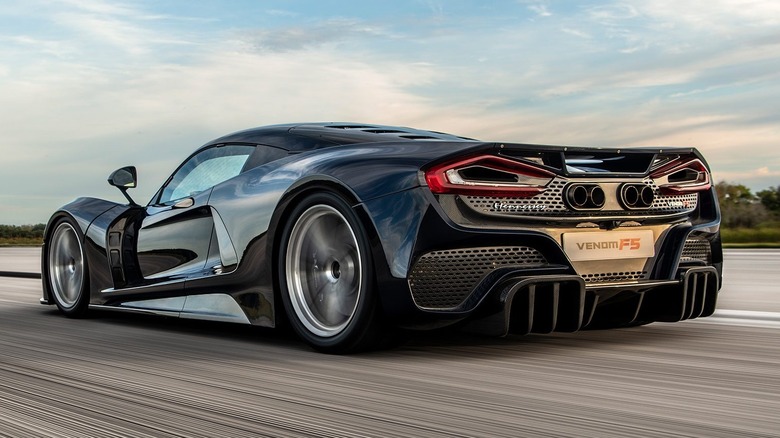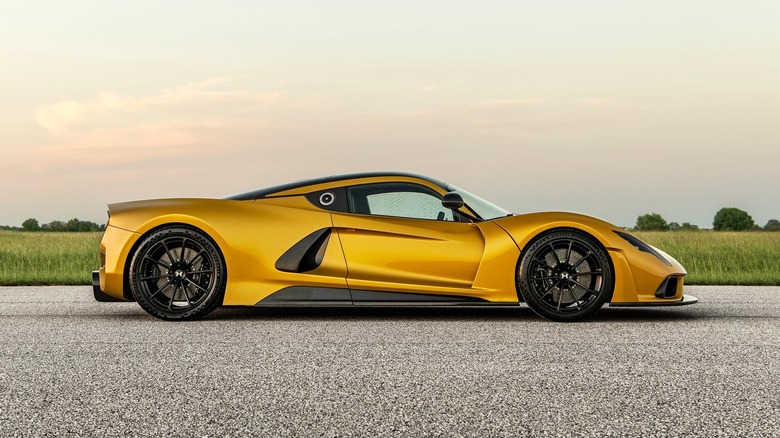What You Never Knew About The Hennessey Venom F5
Anyone lucky enough to be currently in the market for a new hypercar has more choice than ever, thanks to an ever-increasing array of fresh-faced startups and low-volume specials from big manufacturers. They also have more choice of powertrains than prior generations, as the industry is just beginning its shift from internal combustion engines to electric motors. Even market leaders like Bugatti are now focused firmly on the future, with the brand leaving its gas-guzzling V16 behind and preparing to launch an electric hypercar that it claims will "reinvent" the genre.
Among all this talk of change, there are a few companies that remain intent on optimizing their existing technology before trying anything new. For example, Pagani recently announced its latest all-new model, the Utopia, which comes with a traditional Mercedes-AMG bi-turbo V12 which sends 864 horsepower to its rear wheels. That might sound like a lot, but it pales in comparison to the latest offering from American carmaker Hennessey, whose Venom F5 packs over double the horses while weighing roughly the same as its Italian rival. Hennessey is far from the biggest name in the hypercar world, but it has extremely bold ambitions, with the brand hoping to prove that the Venom F5 is the fastest road-legal production car ever made.
An all-American hypercar
Hennessey can trace its roots back to the early '90s when founder John Hennessey left his previous business and set up a small tuning shop. The company claims to have modified more than 10,000 cars and trucks since it opened, and as well as just tuning vehicles, it offers a "Tuner School" course to teach wannabe shop owners the ways of the trade. Hennessey first began making its own vehicles with the Viper Venom 500, a modified Dodge Viper with custom-built parts and a boosted power output. Then came the Viper Venom 1000, and the Lotus Exige-based Venom GT.
The Venom F5 is the brand's first car built entirely in-house, being designed from the ground up by John Hennessey and his team of engineers. Although the company has worked with a number of external partners to develop specific components, including the engine, the majority of the car remains designed and built at the company's facility in Texas. Developing everything in-house is a costly process, and Hennessey has admitted that profits from its regular tuning business have been instrumental in providing funds for the Venom F5 project. But, the resulting car is one of the first all-American hypercars to reach the market, beating rival projects from the likes of Scuderia Cameron Glickenhaus and SSC.
The fastest car in the world?
Hennessey's single biggest goal for the Venom F5 is to make the fastest car in the world, but officially claiming such a title is a lot more complex than it might seem. The official fastest production car according to Guinness World Records is the Koenigsegg Agera RS, which achieved a top speed of 277.8 mph on a closed highway in Nevada in 2017. The test was conducted over a flying mile in two directions, to account for factors such as slope and wind direction. However, a handful of other cars have achieved higher speeds than the Agera RS, but have not met the Guinness World Records criteria to take the crown.
The Sunday Times reports that Bugatti also has a claim to the title since a Chiron Super Sport 300+ achieved an independently verified speed of 304.77 mph at VW's test track in 2019. However, this was only in one direction, and the car was not technically stock, as Bugatti technicians had removed the car's factory speed limiter. It, therefore, didn't qualify for the Guinness World Records title, despite being almost 30 mph faster than the Agera RS. Then, American carmaker SSC claimed to have broken the record again, with its flagship Tuatara allegedly reaching 331 mph. However, SSC's run was later found to be fake, and the company was forced to apologize. It remains unclear whether the Tuatara is actually capable of breaking the 300 mph barrier like its makers claim it can.
World record ambitions
For Hennessey to convincingly claim the "fastest production car" title, it will have to beat both the Chiron and the Agera RS's records. The company claims that the Venom F5's theoretical top speed is 334 mph, and it has set a target of 311 mph (500 kph) for its record attempt. The plan is to conduct a test according to the Guinness World Record rules, that is, on a two-way run in a totally stock production vehicle. If it can meet the target that the team has set, the Venom F5 would not only become the official fastest car according to the de facto authority on such matters, but it would comfortably beat the top speed set by the Chiron Super Sport 300+.
This should firmly establish it as the world's fastest car, providing that no other hypercars claim an even faster speed in the meantime. Perhaps the only other credible rival to Hennessey is the Koenigsegg Jesko Absolut, which its creators claim has a theoretical top speed of more than 330 mph. So far, Koenigsegg has not signaled any intention to put this theory to a real-world test, but likewise, company CEO Christian Von Koenigsegg hasn't ruled out a future record attempt either. John Hennessey has also remained tight-lipped on the timeline for the Venom F5's record attempt, saying only that the company "just delivered our first car, so we don't need to deliver some top speed news at the same time."
Powered by a 1,817-horsepower V8
Any car looking to break a speed record will need to pack plenty of horses under the hood, and Hennessey has developed a 6.6L twin-turbo V8 to give the Venom F5 an edge. Originally, the company appeared to claim that its V8 engine was built entirely in-house, but it was later clarified that the engine was in fact built by a specialist partner and based on GM's ubiquitous LS V8. In many ways, it's a natural evolution from the company's previous car, the Venom GT, which also featured an LS V8, albeit with fewer bespoke parts.
The Venom F5's powerplant is capable of pushing out an astounding 1,817 horsepower, over 500 horsepower more than its predecessor and nearly 300 more than a Bugatti Chiron Super Sport 300+. To ensure that every component is able to withstand the extreme pressures that such a huge amount of power generation requires, Hennessey has used "extreme duty" forged and billet steel throughout the engine. To keep weight to a minimum, components like the exhaust valves are made of Inconel, a cutting-edge material that's used mostly in Formula 1. An engine this powerful needs a suitable name, and Hennessey christened the V8 "Fury," which seems about right.
An entirely new look
All of Hennessey's previous hypercars have been based on other vehicles, with the Venom GT based on the Lotus Exige, and subsequently, looking like one. However, the Venom F5 was designed from the ground up by Hennessey themselves, which gave the team more freedom when it came to shaping the car's exterior. The design is centered around aerodynamics, with a particular focus on achieving the lowest possible drag, says Hennessey. Every vent on the F5 is real, unlike many other modern car designs, and allow air to be carefully channeled throughout the car for maximum cooling effect.
Not only did the car have to be as functional as possible, but it also had to look great while doing so. Cars like the Ginetta Akula are a great example of where function has been prioritized over form, but with the Venom F5, it seems that Hennessey has been able to balance both perfectly. In fact, the car even won the Red Dot Design Award in 2022, a prestigious industry accolade that's previously been won by the likes of Ferrari and Rolls-Royce.
Aircraft-inspired interior
Very fittingly for a car that aims to break the production speed record, the Venom F5's interior is styled around the cockpit of a fighter jet. Hennessey claims the minimalist cabin embodies "premium simplicity," with nothing to distract the driver from the art of driving. There's plenty of bare carbon fiber on show, with dashes of leather on the doors, dashboard, and seats. A lot of the controls are mounted on the steering wheel, an F1-inspired quirk that again helps the driver keep their eyes on the road.
There are a few niggles that prevent the interior from being called world-class: one of the biggest is the Alpine infotainment system highlighted by Carwow's Mat Watson, which looks decidedly cheap for such an expensive hypercar. There was also an issue with glare on Watson's review car, with the dashboard reflecting onto the windscreen in bright sunlight, obscuring the view ahead for the driver. However, Watson did note that his car was a development vehicle, so it's possible that the glare issue will be fixed before customers get their cars.
A 190 lb chassis
At the center of the Venom F5 is a carbon fiber monocoque chassis that weighs just 86 kg (190 lb). It was a key step in keeping the car as lightweight as possible, helping the car's total dry weight stay under 3,000 lb. It officially weighs 2,998 lb (1,360 kg), less than the Bugatti Chiron Super Sport and the Koenigsegg Jesko. As well as being light, the car's chassis is also more rigid than its predecessor, the Venom GT. The car's double wishbone suspension is linked directly to the monocoque through a pair of braces, transferring forces to the car's shell and aiding its stability at high speed.
The new chassis is also an important feature should the driver get into an accident, as the monocoque is designed to withstand high-speed collisions while the car's subframe components deform to absorb some of the impact. It's especially important since the car has no airbags and few other safety features, so the rigidity of that central cell is all that would stand between a driver and whatever they're about to hit.
It's not just about the numbers
Although the primary aim of the Venom F5 is to break speed records, Hennessey is keen to remind enthusiasts that it isn't just about the numbers. It's designed to be great fun to drive as well, with the company's chief dynamics tester John Heinecy having plenty of input on the overall feel of the car. Key to this is making sure the driver gets plenty of feedback, not only at high speed but at road-legal speeds, too.
It's designed to behave like a race car, but it's not specifically built for the track. Hennessey says that it's instead built for an "all-round driving experience on [the] road and track," although it's hard to think of many public roads where drivers could fully experience the power of the Venom F5 without immediately attracting the attention of the local police force. It won't be driveable for any distance on American roads anyway, as the car reportedly comes with "show and display" titles, which strictly limits road use to just a couple thousand miles a year.
A rare beast
Most hypercars are only made in very small volumes, but the Venom F5's production run is even smaller than most. Just 24 examples of the coupe F5 are set to be built, 12 for the U.S. market and 12 for international markets. Carwow reports that a further 30 examples of the roadster version will be built. Every build slot has already sold out, even though some buyers will have to wait several years for their car to be delivered. Making at least 30 units of the Venom F5 is important for Hennessey, not just for the bottom line, but also for its shot at a Guinness World Record. One of the stipulations of being classed as a "production car" by the officiators is a run of at least 30 being built, and this is what disqualified their previous Venom GT from being eligible for a run.
Owners of the Venom F5 will get a car that's considerably rarer than most other hypercars on the market. Although the Bugatti Chiron Super Sport 300+ was limited to 30 units, 500 Chirons have been built when every variant is taken into account. The similarly quick Rimac Nevera is limited to 150 units, and even the Koenigsegg Jesko Absolut is considerably less rare, with 125 units produced.
Starting price of $1.8 million
As would be expected for such an exclusive piece of machinery, the price for owning Hennessey's latest offering stretches comfortably into seven figures. The exact starting price for the Venom F5 is slightly unclear, with Hennessey's own site reporting a starting price of $1.8 million, but other outlets including The Drive reporting a minimum of $2.1 million. Either way, this is not the kind of car that the average enthusiast will ever be able to get their hands on.
It's hardly what anyone could call a bargain, but it does undercut some of the other hypercars on offer right now. The starting price of the Bugatti Chiron Super Sport 300+ is a reported $3,900,000, and the Koenigsegg Jesko Absolut will set buyers back at least $2,840,000. The Venom F5 will be able to keep up with both of those cars, and it'll cost considerably less, even if Hennessey can't yet claim the same kind of brand prestige that either of its European rivals commands. It remains to be seen whether the Venom F5 does claim the official speed record like Hennessey is hoping it will, but no matter if it's a record breaker or not, it's a stunning piece of tire-shredding artwork that will surely delight anyone with pockets deep enough to buy one.
